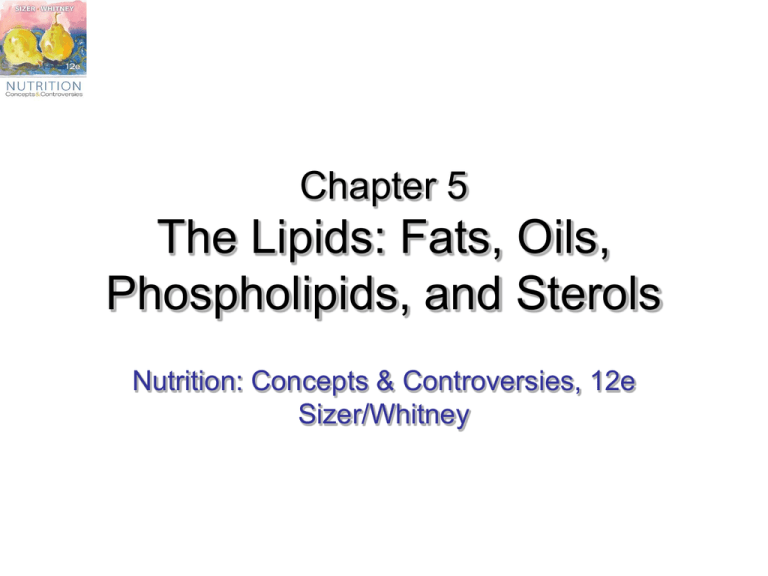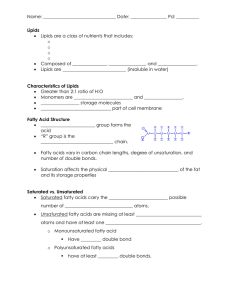Slide 1
advertisement

Chapter 5 The Lipids: Fats, Oils, Phospholipids, and Sterols Nutrition: Concepts & Controversies, 12e Sizer/Whitney Learning Objectives Describe how and where dietary lipids are broken down and absorbed during digestion and how they are transported throughout the body. Describe the significance of the blood tests for HDL and LDL cholesterol. Describe the roles of omega-3 and omega6 fatty acids in the body, and discuss which may be too low in some people’s diets and how they can increase their intakes. Learning Objectives Develop a diet plan that provides enough of the right kinds of fats within calorie limits. Discuss evidence for the benefits and drawbacks of specific dietary fats in terms of their potential effects on human health. Introduction Diet moderate in fats Lipids are necessary and valuable Lipids can harm health Three classes of lipids Triglycerides Phospholipids Sterols Usefulness of Fats in the Body Chief storage form of energy Provides most energy for body’s work Adipose tissue Secretes hormones Purposes of fat Shock absorbers, insulation, cell membranes Fat-soluble substances A Fat Cell Triglycerides: Fatty Acids and Glycerol Triglycerides Glycerol backbone Three fatty acids Fatty acid differences Chain length Saturation Animal species make triglycerides Saturated Versus Unsaturated Fatty Acids Saturation Hydrogen atoms Levels of saturation Saturated Unsaturated Polyunsaturated Monounsaturated Three Types of Fatty Acids Phospholipids and Sterols Phospholipids Glycerol, two fatty acids, and a phosphorus molecule Soluble in water and fat Emulsifier Sterols Roles in the body Plant sterols Digestion and Absorption of Fats Digestion Stomach Small intestine Bile Pancreas The Process of Lipid Digestion and Absorption Storing and Using the Body’s Fat Body conserves fat molecules Fat depots Excess carbohydrate Call for energy Dismantle stored triglycerides Release fatty acids into blood Carbohydrate’s role How to use more fat for energy… Dietary Fat, Cholesterol, and Health Heart and artery disease Saturated and trans fats Beneficial fats Cancer Diet high in saturated fats Obesity Overconsumption of calories Lipoproteins and Heart Disease Risk Lipoprotein movement in the body Liver Types of lipoproteins Chylomicrons Very-low-density lipoproteins (VLDL) Low-density lipoproteins (LDL) High-density lipoproteins (HDL) Lipoproteins Lipoproteins and Heart Disease Risk LDL and HDL difference Size and density Delivery and scavenging Inflammation Heart attack risk Oxidation of LDL Phytochemicals Food Fat, Saturated Fat, and Calories Top Contributors of Saturated Fats to the U.S. Diet The Need for Essential Fatty Acids Essential fatty acids Linoleic acid and linolenic acid Functions Eicosanoids DRI recommendations Deficiencies Omega-6 and Omega-3 Fatty Acid Families Linoleic Omega-6 fatty acid Arachidonic acid Linolenic acid Omega-3 fatty acid DHA and EPA Heart disease Brain function and vision Inflammation Fish Oil Intakes and Cardiovascular Death Rates Recommendations for Omega-3 Fatty Acid Intake Competition for metabolic enzymes Consumption levels Lacking omega-3 fatty acids Fish oil supplements Health concerns with fish oil supplements Omega-3 enriched foods Flaxseed Mercury in Fish Species Effects of Processing on Unsaturated Fats Hydrogenation Effects on fats Oxidation of unsaturated oils Hydrogenation of oils Benefits of hydrogenation Nutrient losses Alternatives to hydrogenation Hydrogenation Yields Both Saturated and Trans-Fatty Acids Effects of Processing on Unsaturated Fats Trans-fatty acids Polyunsaturated fats Change in chemical structure Health effects LDL and HDL cholesterol Similarities with saturated fat Trans fat in foods Fat in the Diet Meat, poultry, fish, dried peas & beans, eggs, & nuts Four categories for meat Limit intake to 5 to 7 ounces per day Choosing low-fat meats Ground turkey or chicken vs. beef Milk, yogurt, and cheese Foods not included in this category Grains Calories, Fat, and Saturated Fat in Cooked Ground Meat Patties Lipids in Milk, Yogurt, and Cheese Lipids in Bread, Cereal, Rice, and Pasta








